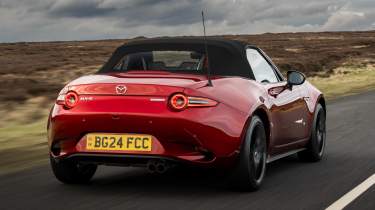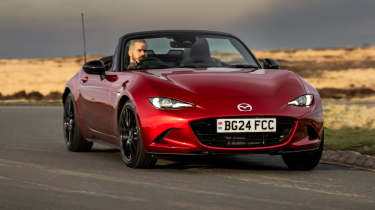Mazda MX-5 review – performance and 0-60mph time
Light weight and rear-wheel-drive traction help the modest power output translate into a reasonable 6.5sec 0-62mph dash for the 2-litre car
An updated 2-litre Mazda MX-5 went on sale in 2018, introducing a heavily revised engine. The 2-litre now has some of the 1.5’s crisp response and willingness to rev (the redline is 500rpm higher than before), as well as a more substantial 181bhp power output.
This extra performance is notable by feel and on paper. The 2-litre reaches 62mph in 6.5sec, a 0.4sec improvement over the previous 2-litre model. As well as the extra 500rpm, the 2-litre the MX-5 retains is an eager, rev-happy mill, even if it lacks the hard-hitting top-end punch of a VTEC. It sounds good too, with a twin-cam naturally aspirated engine note so sorely missed in many of today’s performance models.
Combine this with the MX-5’s lightweight chassis and small footprint and the 2-litre models feel genuinely quick in a way MX-5s seldom have. With the limited-slip diff, controlled burnouts are suddenly on the menu, especially in the wet.
The 1.5-litre car dismisses the 0-62mph sprint in 8.3sec, while top speed is 127mph. But the 1.5’s performance differs more than the numbers suggest, feeling revvy and fun, but noticeably less grunty when cruising. The 1.5-litre car needs working. In a nod to classic MX-5s, it's particularly noticeable on steeper hills when you'll need a downchange to maintain momentum, unlike the 2-litre car which charges up unhindered. Working the gearbox is a pleasure in itself though, and while the 1.5-litre motor doesn't thrill for outright speed, the 2-litre doesn't either, and you're invited to use more of its performance more of the time thanks to its sweeter rasp at the top end.
Being heavier it’s no surprise the RF is marginally slower than the soft-top version. The extra 40kg that the 1.5 MX-5 carries around means that it accelerates from 0-62mph in 8.6sec – 0.3sec slower than the regular car. It feels slightly less urgent in the real world, but overall performance is very similar.




